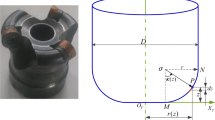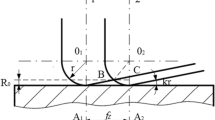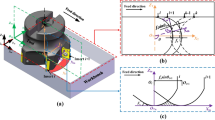Abstract
Surface roughness with topography modeling is one of the most important indicator for evaluating the surface quality in the machining process. This paper establishes a 3D surface roughness prediction model for bevel milling by considering the factors such as milling geometry, motion trajectory, and elastic-plastic deformation. Most of the existing roughness prediction models for bevel milling are based on regression models combined with multiple methods, which makes these models cannot well applied in complicated applications. Aiming at the change of contact area between tool and workpiece in bevel milling, the concept of effective cutting edge is introduced to establish a surface topography simulation model. Furthermore, this model fully considered the milling method, machine perpendicularity, and elastic-plastic deformation. Combined with the international standard of three-dimensional surface roughness, the roughness is predicted according to the residual height of each point on the surface topography. In order to verify the model accuracy and to explore the influence of process parameters on roughness and milling force in bevel and plane milling, two orthogonal experiments are designed in this paper. The experimental results show that the surface topography simulation results are consistent with the actual shape characteristics. The average relative error of roughness prediction is 7.93%, and the minimum is only 0.84%. In addition, the experimental results show that the two factors that have a great influence on the roughness are the spindle speed and feed rate, while the cutting depth and step distance greatly impact on the milling force.













Similar content being viewed by others
Data availability
Not applicable.
References
Misra A, Pulak MP, Dixit US (2017) Modeling and simulation of surface roughness in ultrasonic assisted magnetic abrasive finishing process. Int J Mech Sci 133:344–356. https://doi.org/10.1016/j.ijmecsci.2017.08.056
Wu CJ, Zhang TY, Guo WC, Meng XK, Ding ZS, Liang SY (2022) Laser-assisted grinding of silicon nitride ceramics: micro-groove preparation and removal mechanism. Ceram Int 48(21):32366–32379. https://doi.org/10.1016/J.CERAMINT.2022.07.180
Dong Z, Yan Y, Peng G, Li C, Geng Y (2023) Effects of sandwiched film thickness and cutting tool water contact angle on the processing outcomes in nanoskiving of nanowires. Mater Des 225:111438. https://doi.org/10.1016/J.MATDES.2022.111438
Guo XY, Xu YC, Cao JF, Zhu JH, Zhao YJ, Zhao JW, Shi CY (2022) Laser dressing technology for micro-grooves on the surface of metal-bonded diamond wheels. Diamond Abrasives Eng 42(3):364–372. https://doi.org/10.13394/j.cnki.jgszz.2021.3006
Wang JQ, Yan YD, Li C, Geng YQ (2023) Material removal mechanism and subsurface characteristics of silicon 3D nanomilling. Int J Mech Sci 242:108020. https://doi.org/10.1016/J.IJMECSCI.2022.108020
Doi KT, Aida H, Ohnishi O, Yin SH, Ren YH (2022) Challenges of future high-precision polishing methods for hard-to-process materials by the fusion of environmental control and plasma technology. Diamond Abrasives Eng 42(6):637-649. https://doi.org/10.13394/j.cnki.jgszz.2022.7001
Hossain SJ, Ahmad N (2014) Surface roughness prediction modelling for commercial dies using ANFIS, ANN and RSM. Int J Ind Syst Eng 16(2):156–183. https://doi.org/10.1504/IJISE.2014.058834
Li C, Hu YX, Zhang FH, Geng YQ, Meng BB (2023) Molecular dynamics simulation of laser assisted grinding of GaN crystals. Int J Mech Sci 239:107856. https://doi.org/10.1016/J.IJMECSCI.2022.107856
Li C, Piao YC, Zhang FH, Zhang Y, Hu YX, Wang YF (2023) Understand anisotropy dependence of damage evolution and material removal during nanoscratch of MgF2 single crystals. Int J Extreme Manuf 5:015101. https://doi.org/10.1088/2631-7990/ac9eed
Zhang JR, Lu SW, Shi GF, Xie WK, Geng YQ, Wang ZB (2023) A study on a hybrid SERS substrates based on arrayed gold nanoparticle/graphene/copper cone cavities fabricated by a conical tip indentation. J Mater Res Technol 22:1558–1571. https://doi.org/10.1016/J.JMRT.2022.12.001
Wu C, Li J, Hou TY, Yu NB, Gao XJ (2022) Effect of pad and slurry on fixed abrasive polishing of gallium oxide crystal. Diamond Abrasives Eng 42(6):720–727. https://doi.org/10.13394/j.cnki.jgszz.2022.0043
Li WB, Zhang LJ, Zhang CM, Meng DJ, He PF (2022) The influence of surface topography on friction squeal-a review. J Eng Tribol 236(11):2067–2086. https://doi.org/10.1177/13506501221074807
Zhou T, He L, Wu JX, Du FL, Zou ZF (2019) Prediction of surface roughness of 304 stainless steel and multi-objective optimization of cutting parameters based on GA-GBRT. Appl Sci 9(18):3684. https://doi.org/10.3390/app9183684
Kong DD, Zhu JJ, Duan CQ, Lu LX, Chen DX (2021) Surface roughness prediction using kernel locality preserving projection and Bayesian linear regression. Mech Syst Signal Process 152:107474. https://doi.org/10.1016/j.ymssp.2020.107474
Lu HJ, Xu WF, Wang H, Wang XZ (2023) Microstructure evolution and its effect on the corrosion of dissimilar aluminum alloys friction stir welding joint. Corros Sci 220:111249. https://doi.org/10.1016/j.corsci.2023.111249
Patel KA, Brahmbhatt PK (2016) A comparative study of the RSM and ANN models for predicting surface roughness in Roller Burnishing. Procedia Tech 23:391–397. https://doi.org/10.1016/j.protcy.2016.03.042
Asiltürk I, Çunkaş M (2011) Modeling and prediction of surface roughness in turning operations using artificial neural network and multiple regression method. Expert Syst Appl 38(5):5826–5832. https://doi.org/10.1016/j.eswa.2010.11.041
Joshi K, Patil B (2020) Prediction of surface roughness by machine vision using principal components based regression analysis. Procedia Comput Sci 167(C):382–391. https://doi.org/10.1016/j.procs.2020.03.242
Vidal M, Ostra M, Imaz N, García-Lecina E, Ubide C (2015) Feature descriptors from scanned images of chromium electrodeposits as predictor parameters of surface roughness and crystallographic texture. Chemom Intell Lab Syst 149:90–98. https://doi.org/10.1016/j.chemolab.2015.10.004
Li SY, Li SC, Liu Z, Anton VP (2022) Roughness prediction model of milling noise-vibration-surface texture multi-dimensional feature fusion for N6 nickel metal. J Manuf Process 79:166–176. https://doi.org/10.1016/J.JMAPRO.2022.04.055
Patel DR, Kiran MB (2020) Non-contact surface roughness measurement using laser speckle technique. IOP Conference Series: Mater Sci Eng 895(1):012007. https://doi.org/10.1088/1757-899X/895/1/012007
Wang RW, Zhang S, Ge RJ, Luan XN, Wang JC, Lu SL (2021) Modified machined surface topography modeling in ball-end milling process. Comput Integr Manuf Syst 27(04):973–980. https://doi.org/10.13196/j.cims.2021.04.001
Huang ZH, Wang QH (2013) A methodology to generate cutter swept volume in five-axis milling based on switch of initial curves. Mach Design Manuf 04:14–16. https://doi.org/10.19356/j.cnki.1001-3997.2013.04.005
Liu XB, Masakazu S, Abhijit S, Kazuo Y, Masahiko M (2006) A geometrical simulation system of ball end finish milling process and its application for the prediction of surface micro features. J Manuf Sci Eng 128(1):74–85. https://doi.org/10.1115/1.2039098
Costes JP, Moreau V (2011) Surface roughness prediction in milling based on tool displacements. J Manuf Process 13(2):133–140. https://doi.org/10.1016/j.jmapro.2011.02.003
Francesco B, Giuliano B, Nørgaard HH (2020) Surface topography analysis of ball end milled tool steel surfaces. Procedia CIRP 87(C):153–158. https://doi.org/10.1016/j.procir.2020.03.002
Arizmendi M, Jiménez A (2019) Modelling and analysis of surface topography generated in face milling operations. Int J Mech Sci 163(C):105061. https://doi.org/10.1016/j.ijmecsci.2019.105061
Song WG, Liu ZQ, Yao GH, Khan AM, Cai YK (2022) Effect of workpiece work hardening on machined surface topography generated in two-step milling process. J Manuf Process 77:348–360. https://doi.org/10.1016/J.JMAPRO.2022.03.039
Sui XL, Zheng Y, Jiang JG, Feng XM (2014) Establishment of surface topography simulation model with considering vibration and wear of ball-end milling. Int J Smart Home 8(1):207–216. https://doi.org/10.14257/ijsh.2014.8.1.22
Guo MX, Liu J, Pan LM, Wu CJ, Jiang XH, Guo WC (2022) An integrated machine-process-controller model to predict milling surface topography considering vibration suppression. Adv Manuf 10(3):443–458. https://doi.org/10.1007/S40436-021-00386-7
Dang XB, Wan M, Yang Y (2021) Prediction and suppression of chatter in milling of structures with low-rigidity: a review. J Adv Manuf Sci Technol 1(3):2021010. https://doi.org/10.51393/j.jamst.2021010
Xu JT, Zhang H, Sun YW (2018) Swept surface-based approach to simulating surface topography in ball-end CNC milling. Int J Adv Manuf Technol 98(1-4):107–118. https://doi.org/10.1007/s00170-017-0322-1
Wang B, Zhang Q, Wang MH, Zheng YH, Kong XJ (2020) A predictive model of milling surface roughness. Int J Adv Manuf Technol 108(3):2755–2762. https://doi.org/10.1007/s00170-020-05599-x
Yan GW, Zhang DS, Xu JT, Sun YW (2023) Corner smoothing for CNC machining of linear tool path: a review. J Adv Manuf Sci Technol 3(2):2023001. https://doi.org/10.51393/j.jamst.2023001
Yu X, Wang YQ, Zhang P, Song AL, Xu CW (2022) Chip evolution mechanism in high speed oblique cutting of 7N01 aluminium alloy. Surf Tech, 2022 51(3):167–177. https://doi.org/10.16490/j.cnki.issn.1001-3660.2022.03.017
International Organization for Standardization (2012) ISO 25178 Geometrical product specification (GPS). World Standard Press, Switzerland
Funding
This work is supported in by the Fundamental Research Funds for the Central Universities (2232023D-15), the China Postdoctoral Science Foundation (2022M721910), and the Shanghai Natural Science Foundation (22ZR1402400). The authors wish to record their gratitude for all the generous supports.
Author information
Authors and Affiliations
Contributions
Tangyong Zhang conducted the model setup and wrote the paper. Chongjun Wu designed the whole conception and theoretical analysis. Cong Chen and Long Wang helped in completing the experiments. Jianguo Zhang and Zhijian Lin contributed to polish the manuscript. All authors have read and agreed to the published version of the manuscript.
Corresponding author
Ethics declarations
Ethics approval
We confirm that this manuscript is original and has not been published, it is also currently not under consideration for publication elsewhere.
Consent to participate
Not applicable.
Consent to publish
Not applicable.
Conflict of interest
The authors declare no competing interests.
Additional information
Publisher’s Note
Springer Nature remains neutral with regard to jurisdictional claims in published maps and institutional affiliations.
Rights and permissions
Springer Nature or its licensor (e.g. a society or other partner) holds exclusive rights to this article under a publishing agreement with the author(s) or other rightsholder(s); author self-archiving of the accepted manuscript version of this article is solely governed by the terms of such publishing agreement and applicable law.
About this article
Cite this article
Zhang, T., Wu, C., Chen, C. et al. 3D bevel surface topography analysis and roughness prediction by considering the cutter-workpiece dynamic interaction. Int J Adv Manuf Technol 129, 335–352 (2023). https://doi.org/10.1007/s00170-023-12265-5
Received:
Accepted:
Published:
Issue Date:
DOI: https://doi.org/10.1007/s00170-023-12265-5




